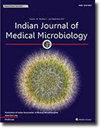Mayaro病毒和基孔肯雅病毒在Vero细胞中的异源干扰
IF 1.4
4区 医学
Q4 IMMUNOLOGY
引用次数: 0
摘要
马亚罗病毒(MAYV)和基孔肯雅病毒(CHIKV)是具有不同自然载体但有共同脊椎动物宿主的致关节炎性甲病毒,它们在中南美洲的伴随传播为人类混合感染提供了机会。鉴于此,我们旨在研究这些虫媒病毒在灵长类细胞系共感染和重复感染期间的异源干扰。方法采用相对比光镜法、荧光法和逆转录-定量聚合酶链反应法分别检测MAYV和CHIKV分别单独、同时或连续感染的细胞病变效应、细胞活力和病毒载量。结果所有感染方案均导致强烈的细胞病变效应,并在感染后24 h内细胞活力平均降低近90%。虽然在合并感染中两种病毒的载量之间没有统计学上的显著差异,但与各自的单次感染相比,观察到个体病毒载量减少了90%以上。此外,超感染导致每种病毒形成的后代数量存在很大差异,无论哪种病毒都具有先发优势。结论在灵长类动物细胞共感染和重复感染过程中,甲型h1n1流感病毒和甲型h1n1流感病毒受到异种干扰,可能影响人类的疾病转归。本文章由计算机程序翻译,如有差异,请以英文原文为准。
Heterologous interference between Mayaro and Chikungunya viruses in Vero cells
Purpose
Mayaro virus (MAYV) and Chikungunya virus (CHIKV) are arthritogenic alphaviruses with distinct natural vectors but common vertebrate hosts, whose concomitant circulation in Central and South America provides opportunities for mixed infections in humans. In view of this, we aimed to investigate the heterologous interference between these arboviruses during coinfections and superinfections in a primate cell line.
Methods
Experimental infections with MAYV and CHIKV were performed singly, simultaneously or consecutively, and cytopathic effect, cell viability and virus load were assessed by phase contrast light microscopy, fluorimetry and reverse transcription-quantitative polymerase chain reaction, respectively.
Results
All infection schemes led to a strong cytopathic effect accompanied by an average reduction of almost 90 % in cell viability within 24 h post-infection. Although there was no statistically significant difference between the loads of both viruses in coinfections, a decrease in the individual virus load of more than 90 % when compared to their respective single infections was observed. Furthermore, superinfections resulted in widely significant differences in the amount of progeny formed for each virus, with a first-mover advantage regardless of the species.
Conclusions
MAYV and CHIKV are subject to heterologous interference during coinfections and superinfections in primate cells, which could possibly impact disease outcome in humans.
求助全文
通过发布文献求助,成功后即可免费获取论文全文。
去求助
来源期刊

Indian Journal of Medical Microbiology
IMMUNOLOGY-
CiteScore
2.20
自引率
0.00%
发文量
154
审稿时长
73 days
期刊介绍:
Manuscripts of high standard in the form of original research, multicentric studies, meta analysis, are accepted. Current reports can be submitted as brief communications. Case reports must include review of current literature, clinical details, outcome and follow up. Letters to the editor must be a comment on or pertain to a manuscript already published in the IJMM or in relation to preliminary communication of a larger study.
Review articles, Special Articles or Guest Editorials are accepted on invitation.
 求助内容:
求助内容: 应助结果提醒方式:
应助结果提醒方式:


